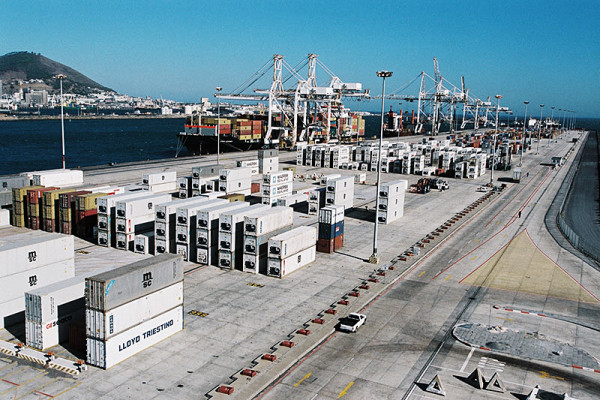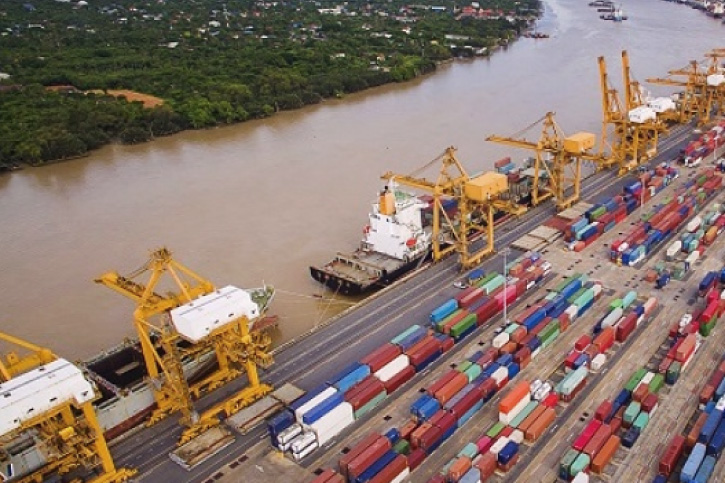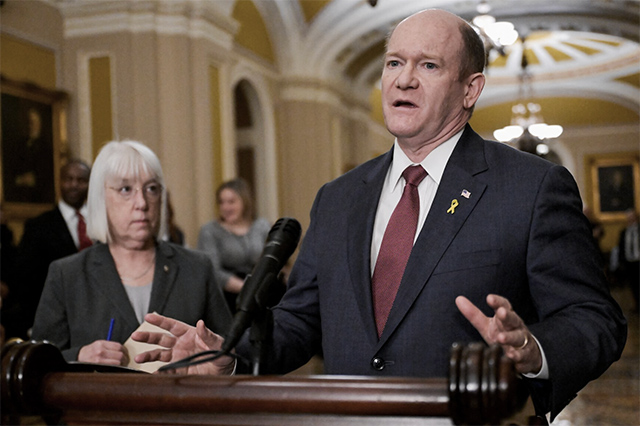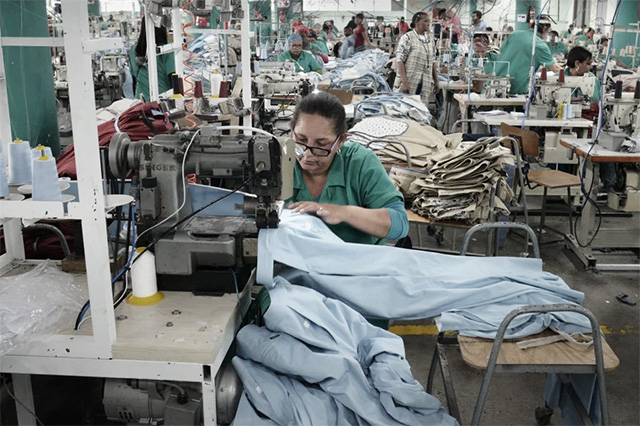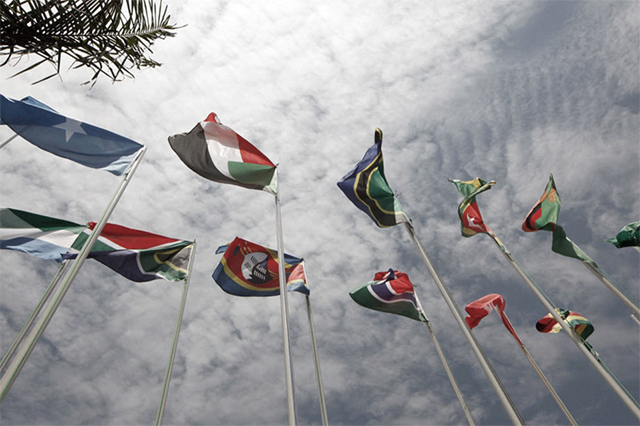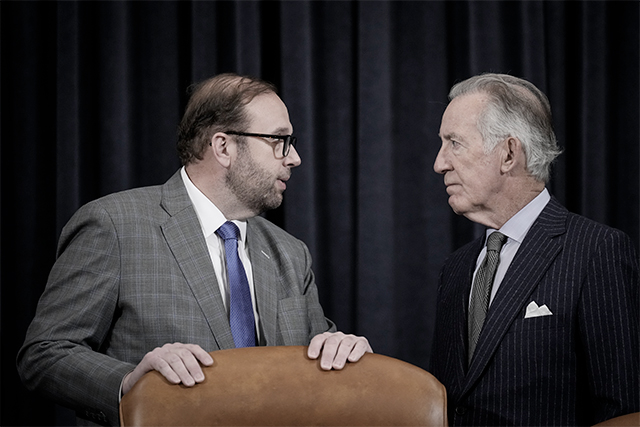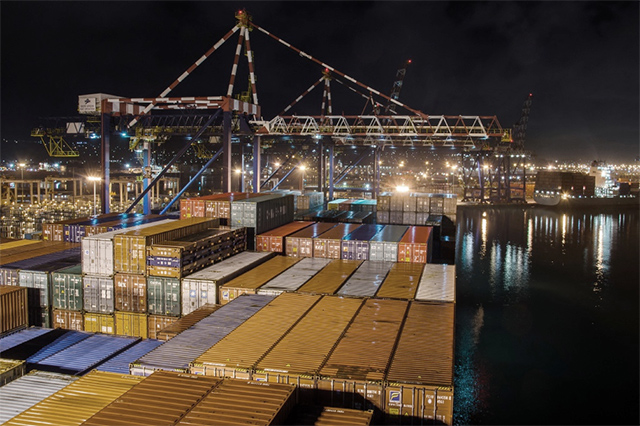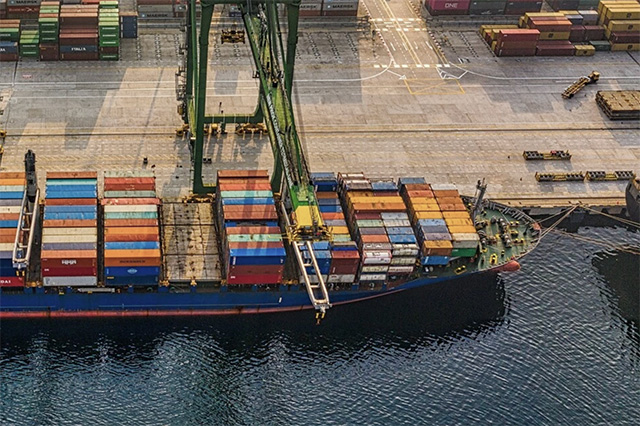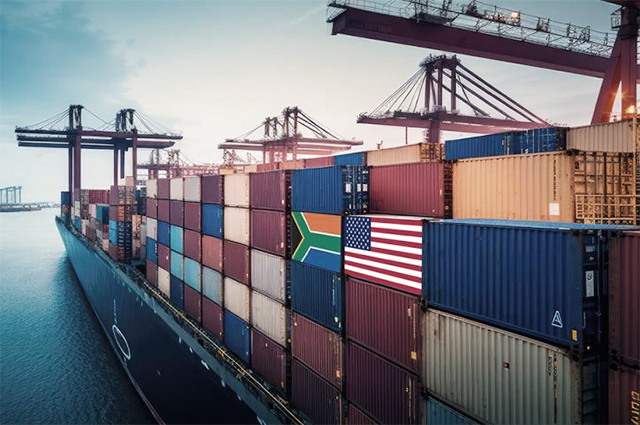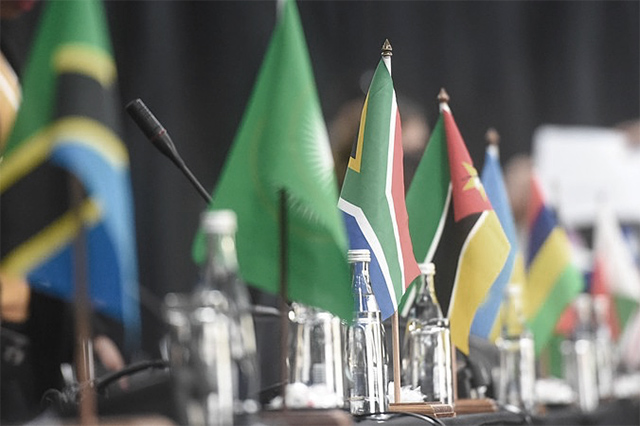Recalibrating US economic engagement with Africa
Nearly 23 years since the United States established the African Growth and Opportunity Act, or AGOA, the continent it was created for no longer exists. In the last two decades, there have been three major shifts that have worked together to cultivate a new Africa—an Africa that requires a different approach to trade and economic investment.
First, there are China’s development initiatives, which have resulted in roads, rails, bridges, and airports. China has also invested in mining, fishing, and manufacturing, and shown African leaders the possibility of a development model that Africans can see and touch.
The second major shift is the birth of the African Continental Free Trade Area agreement, or AfCFTA—a groundbreaking opportunity to both create an industrial revolution within and across Africa and opt out of the types of deals that keep the continent at the bottom of global production, trade, and investments.
And, finally, the creation of Agenda 2063—the African Union’s development blueprint with a goal to attain “inclusive and sustainable economic growth and development.”
Minimally, these developments made it possible for the African Union, or AU, to press for AGOA's renewal in 2025. The union has consistently defended an extension of AGOA because it opened US markets to most sub-Saharan African exports without the need to reciprocate. However, the emergence of new perspectives will determine how the AU values and pursues partnerships with the rest of the world—including the United States.
The upcoming renewal of AGOA offers the United States the opportunity to establish a truly development-oriented partnership that emphasizes growing industrial and trade capacity, and overcomes the foundational bottlenecks that have hindered AGOA’s potential. It’s what I call an AGOA-pluspackage, and it does two things:
First, it extends the nonreciprocal AGOA preferences. Second, it shows a strong US commitment to the African Continental Free Trade Area agreement, especially to build African production capacity in areas prioritized by State leaders. This partnership could advance technology, financing, and investments in industry initiatives linked to sectors included in both frameworks—especially for women and young entrepreneurs.
An AGOA-plus package is in the strategic interest of the United States, and it should be cocreated with African States to ensure AGOA’s objectives of economic growth—through good governance and free markets—are met.
The Africa Growth and Opportunity Act: From promise to practice
AGOA offers sub-Saharan African countries duty-free access for 5,240 tariff items if the goods are wholly obtained or sufficiently manufactured in an AGOA country. Its singling out of sub-Saharan Africa from the broader group of developing countries has long shown what a trade-led pathway beyond aid can look like, offering eligible countries the possibility to enter the lucrative US market on terms better than those available to other World Trade Organization members.
Cocoa and rubber offer some variation—2019 figures show exports worth $50 million for cocoa paste and cocoa butter, and $21 million for rubber and allied products—however, the broad picture across most countries is one of undiversified exports.
According to the Brookings Institution, in 2014 crude oil accounted for 46 percent of all AGOA imports, with energy-related products more generally representing 67 percent of all AGOA imports into the United States. US International Trade Commission statistics show US imports from sub-Saharan African countries increased by $4.9 billion between 2016–2018, with imports of Nigerian crude petroleum and South African precious metals, non-numismatic coins, and diamonds taking the lead.
Under AGOA for the same period, crude petroleum and petroleum products from Nigeria were the main driver behind the $2.0 billion (12.9 percent) increase in US imports, accounting for about three-quarters of the overall increase in US imports under AGOA.
In assessing a new US engagement with Africa, it is important to understand why AGOA has not benefitted more sectors.
Aligning AGOA to Africa’s preferred development approach
Agenda 2063, adopted by the African Union Summit in January 2015, is the compass for Africa’s future. When AGOA was enacted, there was no continent-wide development strategy to which all African Union member states subscribed. At the heart of Agenda 2063—subtitled The Africa We Want—is integration with the African Continental Free Trade Area agreement, industries that will create wealth in Africa, and the movement of people as key priorities.
AU Heads of State reiterated their commitment to these ambitions just last November at the Extra Ordinary Industrialization Summit. All future partnerships should contribute to Agenda 2063’s grand objectives, and a US-Africa trade and investment partnership should be centered around accelerating Africa’s industrialization.
This requires looking beyond trade to include investments in complementary factors, like technology, human capital, and productive capacities. To that end, the United States must incentivize American institutions and companies to share technology that advances Africa’s industrial drive, with a focus on diversification and away from exporting raw materials.
This approach to US relations with Africa requires investments in concrete industrial projects within Africa so that the partnership can enable African economic growth.
Of course, the primary responsibility to create conditions for prosperity lies with African countries themselves, their governments, and people. Ensuring that African governments prioritize improving their own performance must be an important part of the US-Africa partnership. Boosting the capability of standards-setting institutions, testing laboratories, and export facilitation are some areas that African governments should prioritize as a down payment for greater results from this partnership. This would benefit initiatives under AGOA and AfCFTA.
Pandemics, wars, and lessons for AGOA
African leaders are still dealing with the effects of the COVID-19 pandemic. On the one hand, COVID-19 demonstrated the risk of overreliance on the import of medicines, personal protective equipment, vaccines, and pharmaceuticals. On the other hand, it illuminated the fault lines in a trade policy that did not incentivize domestic production of these key resources.
With international borders closed and supply chains broken, Africa’s resilience surfaced as Rwanda manufactured masks that mitigated the spread of the virus, and Senegal produced vaccines—both of which are products that are normally (99 percent) imported.
The war in Ukraine further affirmed what COVID-19 laid bare. According to a 2022 United Nations Development Program report, Africa’s reliance on Ukraine and Russia for its grain imports exposed a sharp vulnerability, with major concerns emerging around food, fuel, and fertilizer. The role of trade policy in responding to these challenges are at the forefront of African leaders’ minds and they will want a US partnership that strengthens, not weakens, Africa’s resilience.
The shift toward ‘Make in Africa’
The most seminal shift post-AGOA is the emergence of the African Continental Free Trade Area: a treaty that binds 44—and counting—of the 55 African countries, offering preferential tariff and service regulations between them to advance industrialization within Africa.
Much has been written about the transformative power of AfCFTA. In 2021, the UN Development Program simulated 18 months of AfCFTA’s regulations as part of COVID-19 recovery. It showed that African businesses would reap about $500 billion in revenues. The sectors in which women are most represented stood to increase by about 18 percent—nearly double earlier predicted estimates. All of the assessments agree that AfCFTA is Africa’s strongest accelerator for industrial transformation.
AfCFTA’ s promise—to offer its state parties zero-duties on an initial 90 percent of tariffed products and nondiscriminatory treatment in the priority service sectors of transport, communication, finance, business services, and tourism—merges the power of nondiscrimination with Africa’s need to industrialize, creating the world’s largest free trade area by a number of members.
Because AfCFTA member states collectively own some of the world’s largest and most precious natural resource reserves, AfCFTA has real potential to disrupt global production systems to the benefit of Africa. Those who move quickly to establish relationships with Africa anchored in investment and production will be the ones to succeed.
A 2021 report from both the AfCFTA Secretariat and UNDP identified 10 value chains emerging from the exchange of tariff and service offers among AfCFTA state parties. This can inform business, with a level of certainty, on where to invest for the AfCFTA markets.
This report surfaced opportunities in automobiles; lithium-ion batteries; clothing, textiles, and apparel; cocoa, soya, and leather products; pharmaceuticals and vaccines; mobile financial services; and entertainment and cultural services. These are some of the sectors that partners like the United States should pay attention to.
The novelty of AfCFTA is that it is a trade-led solution out of the poverty trap that has gripped African countries for decades. By opening up markets for intra-African trade, AfCFTA creates opportunities on the continent: an approach that differs from Africa’s trade with the rest of the world, including the United States, which is largely dominated by exporting raw materials.
The United Nations Economic Commission for Africa studied intra-African trade and confirmed that it “embodies a far larger share of industrial and value-added goods than Africa’s trade with the rest of the world.”
From AGOA’s perspective, this raises the question of why African countries are unable to export similar volume of product to the United States. Typically, this points to production challenges and meeting US standards—whether hygienic agriculture standards, technical specifications relating to testing and labeling, or other certifications such as verifying origin. A post-2025 US-Africa partnership must correct these issues—including through strengthening US investments within Africa and leveraging capabilities of US enterprises to produce goods with African businesses.
A recalibrated agenda for a reinvigorated US-Africa trade partnership
There is a unique opportunity to create a meaningful US-Africa partnership. An AGOA-plus model answers, at least in part, that important question on the minds of Africa’s leaders: how to build resilience—in production and supply chains—with AfCFTA at the center.
Here are five key policy recommendations to frame a recalibrated US-Africa trade partnership.
- Place mutual respect at the heart of deliberations. The US government should come to the table with a demonstrable interest in listening to and exchanging ideas with Africa, as well as an openness to be guided by Africa. The conversation should be about an effective US-Africa partnership for sustainable development. Getting this right is essential because the discussions are with an empowered and stronger African Union.
- Establish that AGOA is only one part of US-Africa economic cooperation: the future must be AGOA-plus. There are other, equally important tenets of the economic relationship like investment, industrialization, financing, technology transfer, and effective trade capacity-building focused on the infrastructure of trade.
- Extend and expand AGOA beyond 2025. However, an extended AGOA should learn from what has and has not worked to ensure that the next iteration expands Africa’s market share and accelerates sustainable development.
- The United States should invest strongly in an AfCFTA exports accelerator that focuses on building production and export capacity. A list of bottlenecks that have constrained both AGOA and intra-African trade is an important reference point for the accelerator’s design. Working with the AfCFTA Secretariat and other relevant AU organs, take a collaborative approach. This could be along the lines of the Memorandum of Understanding announced by President Biden at the recently concluded US-Africa Leaders' Summit.
- The US government should utilize the African diaspora to support AfCFTA, leveraging their deep roots in the continent, which are valued beyond quantifiable financial gain. The diaspora investors are more likely to stay the course even where the proverbial valley of deaththreatens entrepreneurial ventures, mainly because Africa is home for them, too. Investors and remitters are also likely to calculate the rewards in lieu of the strengthening of cultural bonds and the reinforcement family and identity connections. There have been important welcoming initiatives, like the Ghana Year of Return, in which the diaspora showed considerable interest. AfCFTA must be that opportunity that drives this diaspora partnership in all African countries that have ratified the Agreement.
This fundamental truth holds: the US can do more to effectively support Africa in reaching its full potential for trade-led growth and sustainable development. Now is the time for an AGOA-plus approach that takes the lessons from the past 22 years to shape a mutually beneficial partnership.
Doing this well will require the United States to embrace its responsibility as a global leader on development. This will necessitate holding firm against the temptation to seek a free trade agreement with Africa. Instead, it will take listening to African priorities, recalibrating the AGOA to suit the Africa of the future, and designing the complementary pieces of the US-Africa economic relationship to ensure this partnership takes Africa toward the continent we all want it to be.
Joy Kategekwa, PhD, is a globally respected expert in international trade and investment law, policy, and capacity development and has an unyielding passion for the power of trade for Africa’s development. She serves as regional strategy advisor at UN Development Program’s Regional Bureau for Africa in New York, where she leads advisory work on the Africa Continental Free Trade Agreement portfolio, and works closely with the Assistant Secretary General and her teams on design and implementation of high-impact, development-accelerating initiatives under the Renewed Strategic Offer in Africa.


